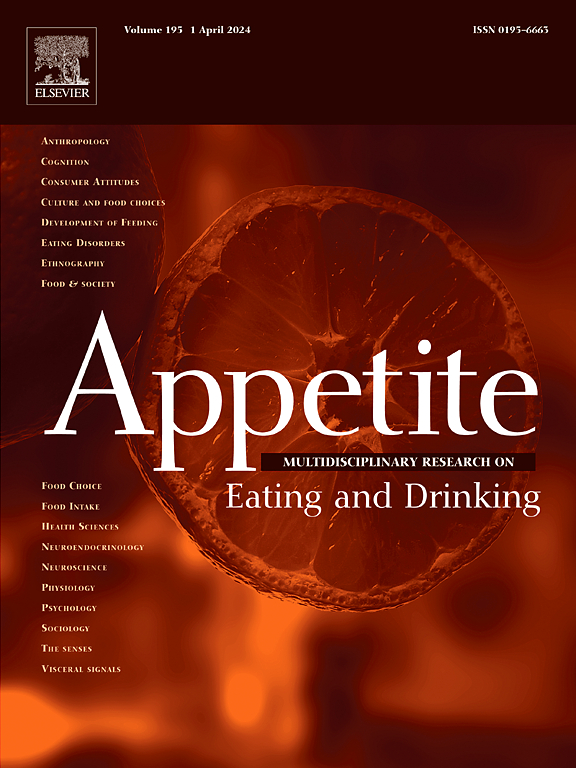‘Eat five a day’ vs ‘Eat one more’: Increased fruit and vegetable consumption when goals are provided, and when goals are more achievable or perceived to be easier
IF 4.6
2区 医学
Q1 BEHAVIORAL SCIENCES
引用次数: 0
Abstract
Background
Three studies investigated ‘achievable’ and ‘relevant’ elements of a fruit and vegetable (FV) consumption goal. Study 1 compared more/less achievable goals (‘Eat 1 more … ’ vs ‘Eat 5 … ’) and no goal on FV outcomes and potential mechanisms. Study 2 investigated more/less achievable and more/less relevant goals (‘ … for current benefit’ vs ‘ … for future benefit’) on FV outcomes and mechanisms. Study 3 examined the goals of Study 2 in a real-world setting.
Methods
Studies 1 and 2 used independent-groups designs, involving 127 and 226 participants, respectively. FV outcomes were intentions to consume FV, immediate FV selection and subsequent FV consumption. Variables studied as potential mechanisms included perceived ease of goal, perceived importance of FV, various attitudes and motivations. Study 3 used a mixed-design involving 10 canteens and 21 4-week FV purchasing assessment periods.
Results
In Study 1, FV consumption was greater after both goals compared to no goal. No differences were found between goals, but FV consumption was positively associated with perceived ease of goal. In Study 2, FV selection and consumption were greater following the more achievable (‘Eat 1 more … ’) goals. Several additional variables were also associated with FV outcomes. In Study 3, FV purchasing was greater during goal display, with no differences between goals. No effects of goal relevance were found.
Conclusions
Our findings demonstrate increased FV consumption when goals are provided compared to no goal. Some benefit was also found from goals that were more achievable or perceived to be easier.
“一天吃五份”vs“多吃一份”:当有目标时,当目标更容易实现或被认为更容易实现时,增加水果和蔬菜的摄入量
三项研究调查了水果和蔬菜(FV)消费目标的“可实现”和“相关”元素。研究1比较了更多/更少可实现的目标(“多吃1个……”vs“多吃5个……”),没有目标的FV结果和潜在的机制。研究2调查了FV结果和机制的更多/更少可实现和更多/更少相关的目标(“……对当前利益”vs“……对未来利益”)。研究3在现实环境中检验了研究2的目标。方法研究1和研究2采用独立组设计,分别纳入127名和226名受试者。FV结果是消耗FV的意图,立即FV选择和随后的FV消耗。作为潜在机制研究的变量包括目标的感知容易程度、FV的感知重要性、各种态度和动机。研究3采用混合设计,涉及10家食堂和21个为期4周的FV购买评估期。结果在研究1中,与没有目标相比,两个目标后的FV消耗都更大。目标之间没有发现差异,但FV消耗与目标的感知容易程度呈正相关。在研究2中,在更容易实现的目标(“多吃一个……”)下,FV的选择和消费更大。几个额外的变量也与FV结果相关。在研究3中,目标展示时的FV购买更大,目标之间没有差异。没有发现目标相关性的影响。结论:我们的研究结果表明,与没有目标相比,有目标时FV消耗增加。人们还发现,更容易实现或被认为更容易实现的目标也会带来一些好处。
本文章由计算机程序翻译,如有差异,请以英文原文为准。
求助全文
约1分钟内获得全文
求助全文
来源期刊

Appetite
医学-行为科学
CiteScore
9.10
自引率
11.10%
发文量
566
审稿时长
13.4 weeks
期刊介绍:
Appetite is an international research journal specializing in cultural, social, psychological, sensory and physiological influences on the selection and intake of foods and drinks. It covers normal and disordered eating and drinking and welcomes studies of both human and non-human animal behaviour toward food. Appetite publishes research reports, reviews and commentaries. Thematic special issues appear regularly. From time to time the journal carries abstracts from professional meetings. Submissions to Appetite are expected to be based primarily on observations directly related to the selection and intake of foods and drinks; papers that are primarily focused on topics such as nutrition or obesity will not be considered unless they specifically make a novel scientific contribution to the understanding of appetite in line with the journal's aims and scope.
 求助内容:
求助内容: 应助结果提醒方式:
应助结果提醒方式:


